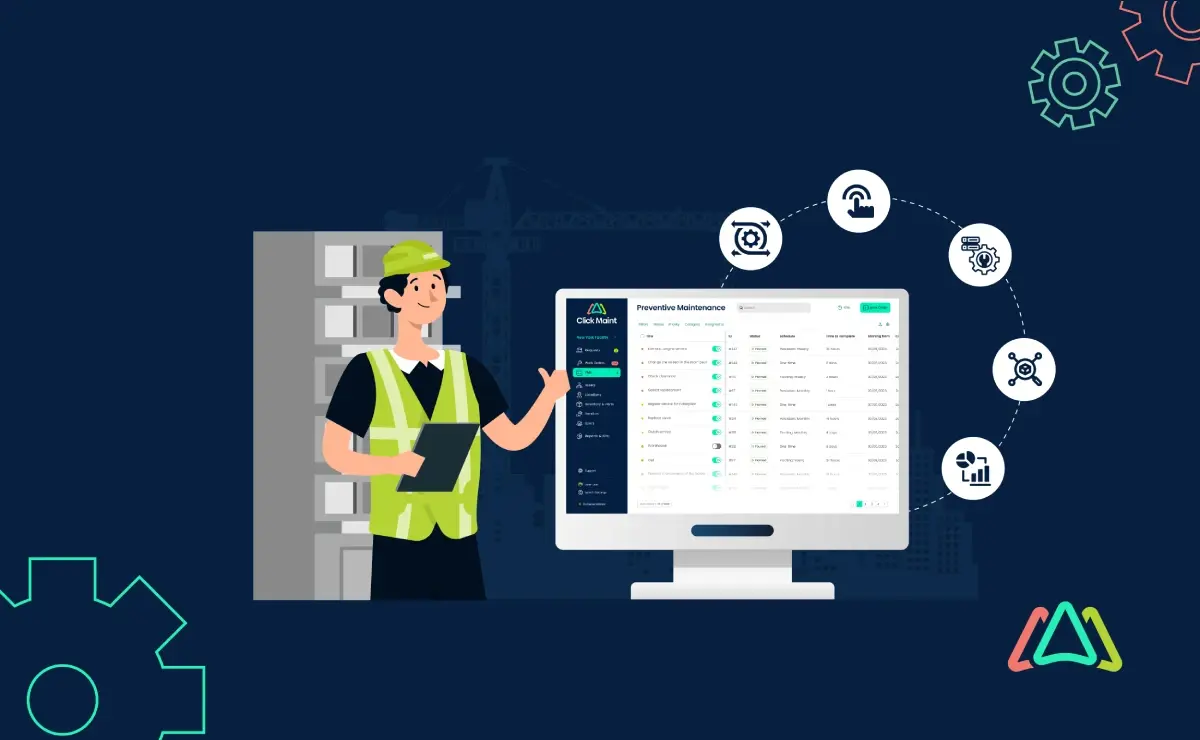
5 Key Considerations for Facility Managers When Choosing CMMS Software
Computerized Maintenance Management Software (CMMS) is a vital tool in modern facility management, serving as the digital nerve center for facility managers monitoring maintenance activities, tracking assets, and optimizing operational workflows. A CMMS software is designed to streamline maintenance activities involved in facilities management. From scheduling preventive maintenance tasks to managing work orders and tracking inventory, its capabilities are many and invaluable. However, not all CMMS solutions are created equal, and choosing the right one is important.
This article discusses five key considerations facility managers should bear in mind when selecting CMMS software tailored to their specific needs. While the goal remains the same – enhancing facility management efficiency. Facility managers have specific needs and duties, therefore choosing a CMMS requires careful consideration.
By understanding the distinct role of facility managers within the broader context of maintenance management, this article aims to shed light on the essential features and functionalities that empower them to be more productive and get better results. From customization and flexibility to preventive maintenance capabilities and advanced reporting tools, each aspect plays a role in elevating facility management practices to new heights of productivity and proficiency.
Understanding the Role of Facility Managers
A facility manager is a professional who oversees the operation and maintenance of a building or facility. The role of a facility manager encompasses a diverse array of responsibilities aimed at optimizing the performance, efficiency, and safety of a facility, extending beyond maintenance tasks and delving into the aspects of strategic planning, budget management, and stakeholder coordination. One of the primary duties of a facility manager is to ensure the operational integrity of the facility through effective maintenance practices. This includes implementing preventive maintenance strategies to prevent critical assets and equipment from breaking down and resulting in expensive repairs, safety risks, and lower levels of accessibility to facility amenities.
Read our blog to learn more about a Facility Manager’s Roles and Responsibilities
Differences between Facility Managers and Maintenance Managers
It's necessary to distinguish the role of a facility manager from that of a maintenance manager, while often used interchangeably, the two roles entail distinct responsibilities. These two roles differ in their scope of responsibilities, objectives, and how each professional utilizes CMMS within an organization.
Scope of Responsibilities
|
Facility Manager |
Maintenance Manager |
|---|---|
|
A facility manager oversees the overall operation and management of a facility, encompassing a wide range of tasks such as strategic planning, space utilization, vendor management, budgeting, and regulatory compliance. They focus on ensuring that the facility functions efficiently and effectively to support the organization's goals and objectives. |
A maintenance manager, on the other hand, is primarily responsible for maintaining and repairing equipment, machinery, and infrastructure within the facility. Their focus is more specific and operational, involving tasks like scheduling preventive maintenance, troubleshooting equipment issues, managing maintenance staff, and ensuring compliance with safety standards. They are also likely to be more hands-on with maintenance activities. |
Strategic and Operational Focus
|
Facility Manager |
Maintenance Manager |
|---|---|
|
Facility managers have a strategic focus, aligning facility management practices with the organization's broader objectives. They are involved in long-term planning, budgeting, and decision-making to optimize the use of facilities and resources. |
Maintenance managers have an operational focus, concentrating on day-to-day maintenance activities and ensuring that equipment and systems operate reliably to support ongoing operations. They are more concerned with immediate maintenance needs and troubleshooting problems as they arise. |
CMMS usage
|
Facility Manager |
Maintenance Manager |
|---|---|
|
Generates comprehensive reports and analytics on facility performance, including maintenance costs and downtime. |
Generates detailed reports and analytics related to maintenance activities, such as work order completion rates. |
|
Tracks and manages all assets within the facility, including equipment, infrastructure, and resources. |
Schedules, tracks, and manages maintenance tasks and activities related to specific assets. |
|
Utilizes CMMS for long-term strategic planning, including predicting maintenance needs and planning upgrades. |
Concentrates on short to mid-term planning, scheduling preventive maintenance, and managing work orders. |
|
Facility managers communicate with internal stakeholders, tenants, or clients regarding facility-related matters. |
Maintenance managers use CMMS for direct communication with maintenance teams, contractors, and technicians regarding work orders. |
While both facility managers and maintenance managers play important roles in ensuring the smooth operation of a facility, they differ in their scope, focus, and how they use CMMS software. Facility managers have a broader strategic focus and oversee the overall management of the facility, while maintenance managers have a more operational focus, concentrating on the maintenance and repair of equipment and infrastructure.
Importance of Preventive Maintenance in Facility Management
One of the primary benefits of preventive maintenance lies in its ability to save substantial costs over the long term. By investing resources in scheduled inspections, routine servicing, and predictive analytics, facility managers can rectify minor issues before they escalate into major repairs or replacements. This not only reduces the overall maintenance expenditure but also extends the lifespan of equipment and assets, maximizing their return on investment (ROI).
Furthermore, preventive maintenance contributes to the longevity and performance of equipment and assets. Regular inspections, lubrication, calibration, and component replacements ensure that machinery operates at peak efficiency, reducing wear and tear over time. This not only prolongs the lifespan of assets but also enhances their operational efficiency, resulting in improved overall performance and productivity.
Overview of CMMS and Its Role in Facility Management
Computerized Maintenance Management Software (CMMS) is an effective tool in facility management. It is used to streamline maintenance tasks, optimize asset performance, and enhance operational efficiency. CMMS software acts as a centralized hub for managing maintenance data, facilitating seamless coordination of tasks, resources, and information across facilities. It automates maintenance workflows, enabling swift creation, prioritization, and tracking of work orders, thus enhancing preventive maintenance practices and minimizing downtime.
CMMS software is an indispensable tool for efficient facility management. It offers comprehensive asset management tools that provide real-time visibility into asset inventory, performance metrics, and maintenance history. With automated scheduling and task assignments, CMMS systems ensure proactive maintenance, reducing the risk of unplanned downtime and costly repairs. Moreover, by enabling communication and collaboration among maintenance teams and stakeholders, CMMS software enhances transparency, accountability, and overall operational effectiveness in facility management.
Key Considerations for Facility Managers When Evaluating CMMS Software
1. Customization and Flexibility
Customization and flexibility are important considerations for facility managers when selecting CMMS software. Integrated features that align with facility management's unique needs ensure optimal functionality and efficiency. A CMMS solution should offer customizable workflows, forms, and reporting tools to accommodate different facility types, company sizes, and industries. This adaptability enables facility managers to configure the software according to their specific operational requirements, enhancing overall effectiveness and user satisfaction.

2. Ease of Use and Accessibility
The usability and accessibility of CMMS software significantly impact its adoption and effectiveness within an organization. Facility managers should opt for a user-friendly CMMS software to help streamline navigation and minimize the learning curve for maintenance teams. Moreover, accessibility across devices, including desktop computers, tablets, and mobile devices, is important for enabling easy collaboration and real-time access to maintenance data. Cloud-based CMMS solutions offer the added benefit of remote access, allowing facility managers to oversee operations from anywhere, facilitating proactive decision-making and efficient resource allocation.
3. Preventive Maintenance Capabilities
Effective preventive maintenance is essential for minimizing downtime and prolonging the lifespan of facility assets. Facility managers should pay more attention to CMMS software that offers robust preventive maintenance features, such as automated scheduling, task lists, and equipment history tracking. These capabilities empower maintenance teams to identify and address potential issues before they occur, ensuring optimal asset performance and reliability. By leveraging preventive maintenance capabilities, facility managers can optimize resource allocation, reduce repair costs, and enhance overall operational efficiency.

4. Asset Management and Tracking
Comprehensive asset management and tracking capabilities are fundamental aspects of CMMS software for facility managers. The ability to accurately track equipment, inventory, and spare parts ensures efficient resource utilization and timely maintenance interventions. CMMS solutions should facilitate asset tracking, maintenance history documentation, and performance analytics to enable data-driven decision-making. Having insights into asset performance and history enables facility managers to make decisions based on the total cost of ownership and decide whether or not to continue maintaining assets or replace them. By centralizing asset information and streamlining tracking processes, facility managers can optimize asset lifecycle management, mitigate risks, and improve operational outcomes.
5. Reporting and Analytics
Reporting tools and analytics play an important role in facilitating data-driven decision-making and performance optimization in facility management. Facility managers should seek CMMS software that offers comprehensive reporting functionalities, allowing them to monitor key performance indicators (KPIs), track maintenance costs, and identify trends or patterns. Advanced analytics capabilities enable facility managers to gain actionable insights into maintenance operations, prioritize tasks, and optimize resource allocation. By leveraging reporting and analytics tools, facility managers can enhance operational efficiency, reduce costs, and drive continuous improvement initiatives.

Other Considerations Worth Mentioning When Evaluating CMMS Software
When evaluating CMMS software options, facility managers should also consider the software provider’s reputation. Ask for a few references from similar industries and company sizes. Also, look into online user reviews and testimonials. Websites like G2 Crowd, Software Advice, and SourceForge are great resources for getting an understanding of the CMMS’s user experience.
Customer support and CMMS costs are also important to consider. User reviews will shed light on the software provider’s customer support. Ensure that the provider offers comprehensive training for users, has accessible digital training resources (videos, articles, webinars), and offers support through multiple channels (email, phone, chat). With regards to CMMS costs, assess the price per user and what features are included in the plan. Most software involves an annual recurring fee. Investigate the policy towards price increases. Also, look at costs for implementation and onboarding.
Conclusion
Selecting the right CMMS software is necessary to enhance facility management efficiency and effectiveness. Customization and flexibility, ease of use and accessibility, preventive maintenance capabilities, asset management, and tracking, as well as reporting and analytics should be the top considerations for facility managers. By prioritizing these factors, facility managers can streamline maintenance operations, optimize asset performance, and drive operational excellence. By investing in the right CMMS solution, facility managers can unlock new levels of efficiency, reliability, and resilience in their maintenance practices, ultimately driving organizational success. Whether it's adapting to a different facility type, ensuring user-friendly interfaces, or leveraging robust preventive maintenance features, choosing the right CMMS software can significantly impact facility management outcomes.
TABLE OF CONTENTS
Keep Reading
Ever find yourself checking into a luxury hotel and expecting a relaxing stay, only to find a ...
11 Apr 2025
Organizations are witnessing swift changes in the business environment and confronting a ...
8 Apr 2025
Last month, news outlets and the entire internet was abuzz with the return of NASA astronauts ...
3 Apr 2025
What comes first - CMMS or predictive maintenance? If your answer is either, it is correct. ...
28 Mar 2025
Artificial intelligence (AI) talk has become commonplace. Today, engaging in business-focused ...
27 Mar 2025
Imagine a world where machines predict, diagnose, and fix their issues before they fail. This ...
25 Mar 2025
A facility maintenance plan is at the core of a facility’s operations. This organized ...
21 Mar 2025
Think of managing your maintenance operations like managing a championship sports team. Just ...
21 Mar 2025
The maintenance sector is battling a severe talent shortage that threatens to undermine ...
7 Mar 2025
Manufacturing maintenance is the backbone of industrial efficiency, ensuring machines run ...
5 Mar 2025
No one likes playing a guessing game when equipment breaks down. Yet, maintenance teams often ...
4 Mar 2025
The size of the preventive maintenance software market is discussed in millions of dollars, ...
4 Mar 2025
The organizational structure and corporate hierarchy vary from company to company. Large ...
28 Feb 2025
Maintenance procedures are essential for ensuring the longevity and reliability of machinery ...
21 Feb 2025
Sustainability is no longer just a buzzword; it's a critical component of corporate social ...
20 Feb 2025
A Computerized Maintenance Management System (CMMS) relies on accurate, well-organized data ...
18 Feb 2025
In an era where technology drives operational efficiency, Computerized Maintenance Management ...
14 Feb 2025
A Computerized Maintenance Management System (CMMS) is a key component of modern maintenance ...
13 Feb 2025
Introduction Maintenance management is the foundation of maintenance operations in industries ...
11 Feb 2025
Introduction A Computerized Maintenance Management System (CMMS) is software designed to help ...
7 Feb 2025





